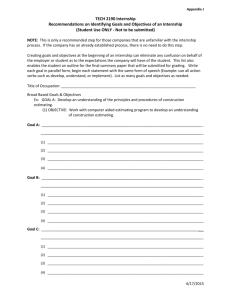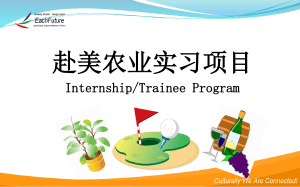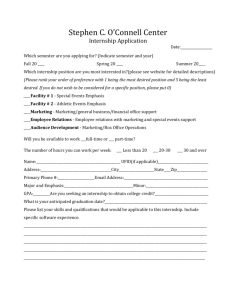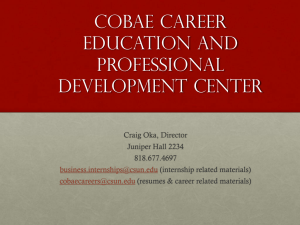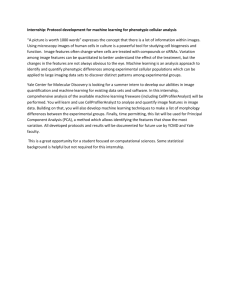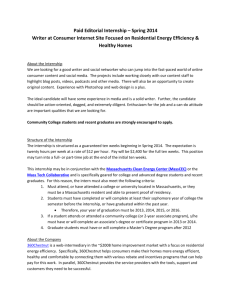Guidelines for Writing the Professional Internship Summary Paper
advertisement
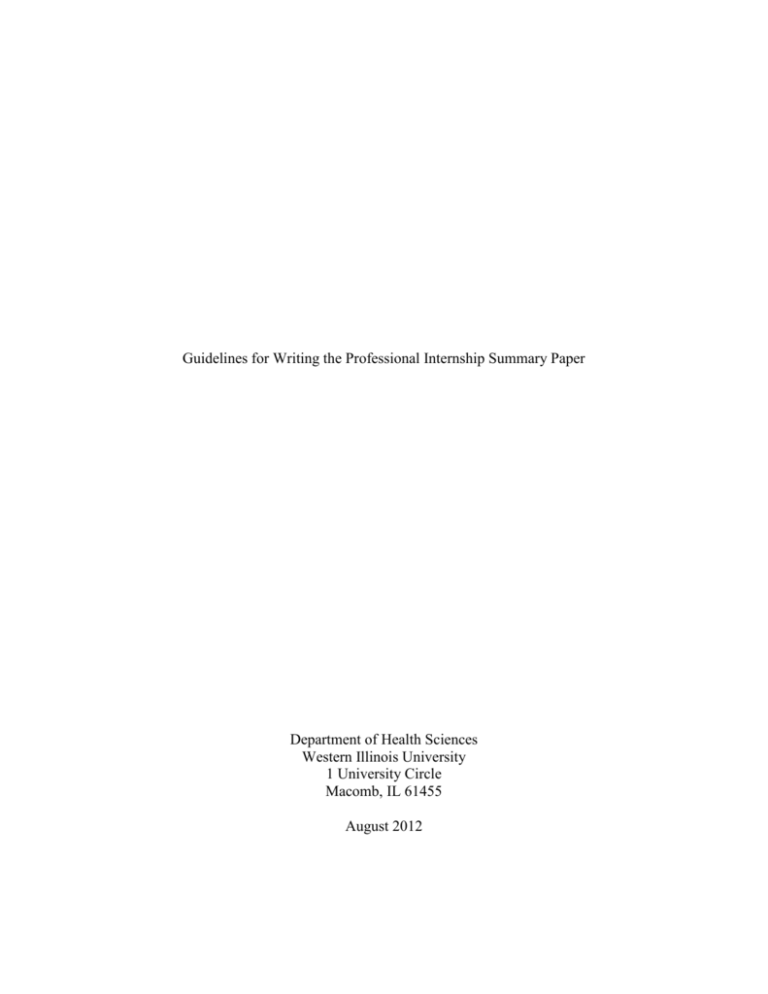
Guidelines for Writing the Professional Internship Summary Paper Department of Health Sciences Western Illinois University 1 University Circle Macomb, IL 61455 August 2012 i Table of Contents Page STYLE FORMAT ................................................................................................................... 1 SEQUENCIAL ORDER OF THE PAPER ............................................................................. 1 Title Page .................................................................................................................. 1 Table of Contents ........................................................................................................ 1 Introduction ................................................................................................................ 1 Structure and Functions of the Agency/Organization ................................................ 2 Description of Experiences and Activities ................................................................. 2 Perception and Judgment about the Internship ........................................................... 2 References ................................................................................................................. 3 Appendices ................................................................................................................. 3 THE INTERNSHIP ORAL...................................................................................................... 3 EXAMPLE TITLE PAGE ...................................................................................................... 5 EXAMPLE TABLE OF CONTENTS .................................................................................... 6 EXAMPLE HEADING USAGE ............................................................................................ 8 EXAMPLE TITLE PAGES FOR CHAPTERS .................................................................... 10 EXAMPLE COVER SHEETS FOR APPENDICES ............................................................ 14 REFERENCES ...................................................................................................................... 17 APPENDICES ...................................................................................................................... 18 A. Frequently Asked Questions About the Final Internship Paper........................... 19 B. Using Word 2012 to Create Parts of the Final Internship Paper.......................... 22 C. Hints on References, In-Text Citations, and Personal Communications ............. 24 1 Style Format The paper that you submit should NOT be considered a draft. The product must: 1. Be formatted using the guidelines in this document. 2. Be typed (using Times New Roman or Courier font). Font size should be 12 point. 3. Be double-spaced. 4. Have one-inch margins on top and bottom and 1 ¼’ margins on each side. 5. Be paginated in the upper right corner. 6. Be left justified. 7. Be printed one-sided. 8. Be thorough and well organized. 9. Be grammatically sound and free of typographical errors. 10. Include a reference list for information cited in chapters 1 and 2 (in APA or AMA format). 11. Be submitted in a 3-ring binder. Preparing a quality, professionally written paper will, in most cases, minimize the chances that faculty reviewers will mandate major revisions. NO ELECTRONIC SUBMISSION (i.e., faxed or emailed) OF SUMMARY PAPERS WILL BE ACCEPTED. Please submit via USPS, UPS, FedEx, DHL, or in person. There are frequently asked questions related to the final internship paper (Appendix A, p. 20). Students often use a software program to create their Table of Contents, in-text citations, and their reference page. Appendix B provides some hints and cautions on use the Word for these purposes (p. 22). Sequential Order of the Paper Title Page An example of proper format for the title page is provided on page 5. Table of Contents An example of proper format for the table of contents is provided on page 6. All headings appearing in the table of contents should also appear in the body of the paper, appropriately placed and italicized as needed in the paper. Introduction This should include a historical review of the agency/organization followed by a current overview IN YOUR OWN WORDS with proper citations of sources from which the information is drawn. Failure to do so will result in a violation of the Academic Integrity Policy found at http://www.wiu.edu/policies/acintegrity.php. The student objectives for the internship should be listed in numerical list format. The cover sheet for this chapter is considered page 1. The 2 page number should be on the upper right of the page. The Table of Contents may be left unpaged, or use small italic letters, beginning with i, ii, iii, etc. Structure and Functions of the Agency/Organization This should be a detailed discussion of the organizational structure and functions of each of the operating units/departments within the ENTIRE agency/organization IN YOUR OWN WORDS with proper citations of sources from which the information is drawn as needed. Discuss how the entire agency is organized, as well as the roles, responsibilities, and programs provided by each operating unit/department. NOTE: Include an organizational chart in the appendices. Make reference to this appendix in Chapter 2. Description of Experiences and Activities This shall consist of a thorough, in-depth discussion of the various experiences and activities the intern was involved in during the internship no matter how minute the task may seem. Make certain this section is written in detail. Explain the major activities first, followed by minor experiences. Leave nothing out! Copies of all projects whether completed or not must be submitted with the summary paper. Do not include materials such as a 100 page orientation manual if you did not assist with the creation. Include these copies in the appendices. Perception and Judgments about the Internship This is the student's own assessment/evaluation of the internship. Elaborate on each of the following in narrative format: The Internship. The following questions should be answered in narrative format. 1. 2. 3. 4. 5. 6. 7. List objectives in numerical list format. Discuss if and how they were achieved. Did the internship meet your personal expectations? Was the organization open to your ideas? Would you like a career in your program major? Would you recommend the organization to other interns? How could this experience have been improved? What was your greatest accomplishment? Work Performance. The following questions should be answered in narrative format: 1. 2. 3. 4. What prior skills did you use in this internship? List new skills and knowledge acquired. Were you satisfied with your performance on assignments and projects? Did you meet deadlines? Did you use your time efficiently? Honestly rate the overall quality of your work. 3 Personal Benefits. The following questions should be answered in narrative format. 1. How have your academic and career goals changed? 2. What impact did this experience have on your personal growth? 3. What insights have you gained regarding your field of study or profession? References Most, if not all, paragraphs in Chapters 1 and 2 should have a citation. These can be personal communications if you obtained information through interviewing methods (personal communications are only found in the text and not the reference list), as well as references of paper documents and web pages. AMA or APA style should be used to format the paper and reference list. Failure to appropriately format and cite references may result in a violation in the WIU academic integrity policy and will handled accordingly. There are resources related to correctly reference in WesternOnline under the module Student Resources. Appendix C has additional information related to references related to personal communications and written manuals and handbooks at the site (p. 24). Appendices Include a copy of each project whether complete or partially complete. Any items you produced in conjunction with the internship should be exhibited. If the items are difficult to three-hole punch or you do not wish to do so, you may use sheet protectors. Every page of the appendix must be paged sequentially in your document and be reflected on the Table of Contents. Other helpful hints include: 1. All appendices included must be discussed in the body of the paper and include a page reference. Cite appendices as in one of the following ways: (Appendix A, p. 23) or Appendix A (p. 23) depending on the sentence format. 2. Appendices are arranged according to the order in which they are discussed in the paper (i.e., the first appendix discussed should be Appendix A; the second should be Appendix B, and so on). 3. Make certain the pages in the appendices are properly numbered. The page number provided in the Table of Contents and cited in the main body of the paper should be consistent. The appendices section should begin pagination where the Reference page ends. See the Table of Contents provided in this document as an example. Use of a black ink pen is acceptable for paginating the appendices only. 4. A cover sheet should be supplied for each appendix (Appendix A, p. ) and paged. 5. Titles of tables, graphs, etc. should be on the right margin. 6. Each appendix must be labeled with Appendix A (or whatever the letter is) and the title. The Internship Oral & Poster Presentation Students will participate in an informal discussion about the learning experience and recommendations for the future. In addition, a poster presentation will be made by each intern on a project the intern completed that showed a major contribution to the organization. Students 4 should be prepared to answer questions from the faculty and students. Site supervisors and the Dean of the College of Education and Human Services will be invited to attend as well. STUDENTS SHOULD WEAR PROFESSIONAL DRESS FOR THE INTERNSHIP ORAL PRESENTATION. 5 Example Title Page Professional Internship Summary Paper [line 15] Completed at XYZ Hospital [line 17] Macomb, IL [line 18] By [line 26] Joe Student [line 28] Submitted in partial fulfillment of the Health Sciences internship requirement [line 37] for EM 490, HS 490, HS 590 (indicate one) [line 38] Western Illinois University [line 39] Month 2012 [line 40] 6 Example Table of Contents Table of Contents Chapter Page I. INTRODUCTION..................................................................................................1 History of Hospital XYZ ........................................................................................1 Internship Objectives .............................................................................................1 II. STRUCTURE AND FUNCTIONS OF XYZ HOSPITAL ....................................2 Vice President ........................................................................................................3 Director of Nursing Services .................................................................................3 Director of Human Resources ................................................................................3 Director of Rehabilitative Services .......................................................................4 Director of Public Affairs/Development ................................................................4 Patient Education Program ....................................................................................5 Patient Education Committee ...........................................................................5 Patient Education Sub-Committee ....................................................................6 III. DESCRIPTION OF EXPERIENCES AND ACTIVITIES ..................................7 Program Planning ...................................................................................................7 Wellness Program for the Elderly .........................................................................7 Women's Health Care Program, XYZ Hospital .....................................................7 Publicize/Promote Health Education Activities ....................................................9 Heritage Days Activities ........................................................................................9 Good Life Column, Business News ...................................................................10 Radio Interview on WXYZ ................................................................................10 Program Implementation .....................................................................................11 Fit for Life Program for Kids .............................................................................11 "Acquainting You with Pediatrics" .....................................................................12 Visiting Other Community Agencies ..................................................................13 XYZ County Rehabilitation Center ....................................................................13 Senior Citizens Program, Macomb YMCA ........................................................14 Gerontology Department, XYZ Hospital .............................................................14 Community Activities ........................................................................................15 Crippled Children Clinic .....................................................................................15 Domestic Violence Volunteers Class ..................................................................16 Parenting Class .....................................................................................................16 Miscellaneous Activities ......................................................................................19 7 IV. PERCEPTION AND JUDGMENTS ABOUT THE INTERNSHIP ...................20 The Internship ........................................................................................................20 Work Performance .................................................................................................21 Personal Benefits ...................................................................................................21 REFERENCES ...........................................................................................................22 APPENDICES ..........................................................................................................23 A. Mission Statement - XYZ Hospital ......................................................................24 B. XYZ Hospital Organizational Chart ....................................................................25 C. XYZ Hospital Goals and Objectives, FY 2012-13 ..............................................26 D. Programs/Services Public Affairs and Development .......................................... 31 E. Letter from Good Life Center ..............................................................................34 F. Good Life Center for Wellness, 1990-91 .............................................................36 G. Gerontology Department, XYZ Hospital .............................................................38 H. Wellness Program for the Elderly Meeting ..........................................................44 I. XYZ Hospital Wellness Program for the Elderly Pilot Program .........................48 J. Planning Facilities to Respond to Women's Health Needs ..................................70 K. Letter to Dr. Sam Page, VP for Public Affairs .....................................................74 L. Health Fair for the Teachers .................................................................................79 M. Quiz for the Heritage Days ..................................................................................83 N. Poster for the Heritage Days ................................................................................85 O. Articles for the Business News ............................................................................86 P. WXYZ Radio Talk ...............................................................................................90 Q. Fit for Life for Kid Program ................................................................................98 R. "Acquainting You with Pediatrics" ....................................................................102 S. XYZ County Rehabilitation Center ...................................................................107 T. YMCA ...............................................................................................................111 U. YMCA - Senior Citizens Program ....................................................................114 V. Lamaze Class .....................................................................................................120 W. Domestic Violence Volunteers .........................................................................128 X. Parenting Class ..................................................................................................131 Y. Hospital Orientation ...........................................................................................133 Z. Living with Diabetes ..........................................................................................137 AA. Diabetic Dietary Clinic .....................................................................................139 AB. Tumor Board ................................................................................................... 143 8 Example Heading Usage The heading style recommended by APA consists of five possible formatting arrangements. (APA, 2010, pp. 62-63) 1. First level headings within the paper should be centered, boldface, and use uppercase and lowercase lettering. The paragraph should begin two lines below the heading and indented as a normal paragraph. For each chapter, the beginning of the chapter should have a main header which is the title of the chapter. Example: Structure and Function of Hospital XYZ You may need subheadings for this chapter. 2. The second level is flush left, boldface, and uses uppercase and lowercase letters. For example in the second chapter, you have a second level header, as shown on the Table of Contents, page 7. Examples: Vice President Patient Education Program 3. The third level of header would be indented, boldface, with a lowercase paragraph ending with a period. With this level of header, only the first letter of the first word is usually capitalized. For committees that have a specific name, the beginning of each word is capitalized as it is a proper noun and refers to a specific committee. An example of a third level header would be: Patient Education Sub-Committee. For the third level of header, the text would start after the period on the same line. This is unlike the headers for level one and two which stay on a line by themselves. 4. Level 4 header (if needed). Indented, boldface, italicized, lowercase paragraph heading ending with a period. 5. Level 5 header (if needed) This type of header would be indented, italicized, lowercase paragraph ending with a period (APA, 2010). Note: Do not label headings with numbers or letters. 9 Example of First Level Heading Structure and Function of Hospital XYZ Examples of second, third, and fourth level headers. Patient Education Committee The participants of the Patient Education Committee assist the Staff Development department in the development and revision of the policies and standards. It conducts educational needs assessments, approves educational packets, and submits approved education packets to the medical staff committee for revision and final approval. Patient Education Sub-Committee. The Patient Education Sub-Committee assists the Patient Education Committee in the development of the patient education programs and packets. It also assists with other special projects. Chair. The chair of the Patient Education Sub-Committee is Mr. John Smith. 10 Example Cover Sheets for Chapters CHAPTER I INTRODUCTION (Counted as a page, but not numbered) 11 CHAPTER II STRUCTURE AND FUNCTIONS OF XYZ COUNTY HEALTH DEPARTMENT 12 CHAPTER III DESCRIPTION OF EXPERIENCES AND ACTIVITIES 13 CHAPTER IV PERCEPTION AND JUDGMENTS ABOUT THE INTERNSHIP 14 Example Cover Sheets for Appendices APPENDICES 15 APPENDIX A Mission Statement - XYZ Hospital 16 APPENDIX B XYZ Hospital Goals and Objectives, FY 2012-13 17 References American Psychological Association. (2010). Publication Manual of the American Psychological Association (6th ed.). Washington, D.C.: Author. 18 APPENDICES 19 APPENDIX A FREQUENTLY ASKED QUESTIONS 20 Frequently Asked Questions Can I use similar language for my project paper when I discuss it in Chapter 3 of my final internship paper? Yes, your narrative in Chapter 3 talking about projects and activities related to each internship objective should also include the project that you'll be presenting at the end of July. The project paper, 3-5 pages, could definitely be used as you construct Chapter 3, with revisions, etc. as needed. If it was me, I wouldn't recreate the wheel entirely for the project paper and the narrative on the project in Chapter 3. Some tweaking to meet the intent or purpose for each document might need to be done. Both will probably have methods, results, etc. Your project write-up for Chapter 3 will show how this helped you meet one or more objectives. The project paper doesn't need to relate to an intern objective, but would be meant more as a stand-alone document, which is why you would include an introduction. What should be included in the appendices? For meetings you just attended, you can mention them in your Chapter 3 narrative. You do not need to put minutes, agendas, or handouts in the appendices unless you actively contributed to the development. If you presented at a meeting, or were active in planning it contributing to the execution (such as taking and completing the minutes), then include in the appendices. Focus on telling your story of your meaningful activities, contributions, and providing the documentation for those in the appendix. I am not looking for a fifty page handout from a 1/2 day meeting that you were given in the appendix. Are there a specific number of pages that must be met for the final internship paper? The length of your narrative depends on the total number of hours you spent at the site, your projects, and your activities. I do not grade on length. I do grade on substance (content), quality, and completeness. I look for thoroughness, readability, organization, strong projects descriptions with results, and strong reflections. If you have less than 18 pages in your narrative, it is probably not thorough enough. If you have more than 60 pages, you may not be presenting concisely. If I receive get a sixty page narrative that is disorganized, not focused and poorly constructed, it's unsatisfactory. In general, I have seen well-written narratives that are 18-40 pages, with an average of 25. The average length of each chapter: Chapter 1-- 3-5 pages; Chapter 2—4-10 pages; Chapter 3—10-20 pages; Chapter 4-- 5-8 pages. 21 Appendices vary. I've seen them from 20 pages to over 100. In some academic courses, some teachers may really stress length, but in the real business world, good writing means clear organization, clear writing, and communicating without a bunch of fluff that wastes the reader's, i.e., my time. What's the difference between the final internship paper and project paper? There are two written products that you'll be completing during the internship. Your final internship paper will follow the final paper internship guidelines posted and will have five chapters, a table of contents, reference page, and appendices. Your project paper will be a 3-5 page paper that will specifically provide more information about your poster project/your major contribution/ and your major project. You will be describing this major project in your final internship paper as well. Where can I get assistance with my writing and correctly referencing information? Mr. Neil P. Baird, Director of the Writing Center at WIU, e-mail NP-Baird @wiu.edu, is willing to assist. However, you are responsible for proofreading. He is willing to provide feedback on drafts remotely, i.e., electronically and through telephone. I know some of you are at a distance from Macomb. What you would need to do is email him your draft. Put in the Subject line: Dr. Clerc Internship Paper. Indicate times you would be available for phone help. Allow him at least three work days. 22 APPENDIX B USING WORD 2010 TO CREATE PARTS OF THE FINAL INTERNSHIP PAPER 23 Using Word 2010 to Create Parts of the Final Internship Paper Use Reference Tab for both Table of Contents (TOC) and References Creating a Table of Contents in Word http://www.youtube.com/watch?v=RcadhM6ZjGQ Also, some information in Word Help Creating Citations and Bibliography Some help in Word Help- Reference tab has citations and bibliography capabilities. You can choose APA style. Note: this works well for basic journal articles, books, etc. http://www.youtube.com/watch?v=MKco%2D0ye3yg The following has a number of great video tutorials on references, citations, and subheadings. http://www.referencepointsoftware.com/tutorials/apa-word/ 24 APPENDIX C HINTS ON REFERENCES, IN-TEXT CITATIONS, AND PERSONAL COMMUNICATIONS 25 Hints on References, In-Text Citations, and Personal Communications Final Paper Internship Revisions I know some of you might need some help with references and in-text citations. I have posted some resources for you in D2L under Student Resources.. I also recommend http://owl.english.purdue.edu. I found this very user friendly to find specific answers to questions. APA or AMA style format is acceptable. I found many students used the reference and citation functions in Word. This will work for traditional books and journal, but does not work for many nuances, such as personal communications. An example of a personal communication, such as an interview, would be an in-text citation (First Initial. Last Name, personal communication, month date, year) Personal Communications Example: If you interviewed me about the history of your organization you would do an in-text citation following the information. Use the following guide: (FI. Last Name, personal communication, Month day, year) (APA Manual, 2010). The organization began in 1924 (J. Clerc, personal communication, May 31, 2012). OR Dr. Jeanne Clerc (personal communication, May 31, 2012) indicated the organization began in 1924. Since there are no written records of personal communications, you do not list them on your reference page. Written References Any written references or electronic versions must be listed on the Reference Page. Book. The general order for a book would be: Author Last Name, FI MI(if known). (year or date). Title. Location of Publisher: Publisher. (APA Manual, 2010). Journal Article from an Electronic Source. For a journal article from an electronic source: “Author, A.A., Author B, B.B., & Author C.C. (year). Title of article. Title of Periodical. Xx, pp-pp. doi: xx.xxxxxxxxxxxx” (APA Manual, 2010). 26 The doi is known as the digital object identifier. If unknown, use this format: Retrieved from http://ww.xxxxxx. A Written Handbook or Manual. For a reference that exists as a written handbook at the site: “Author(s). (Year of Publication). Title. Location of Publisher: Publisher” (APA Manual, 2010). Example: Beloit Regional Hospice. (2012). Policy and Procedure Manual for Beloit Regional Hospice. Beloit, Wi: Author. In this case, we assume individuals at the site authored the manual. It would also be correct to assume the author is unknown. In this case, put in the information that you do know and you would begin with the title. Policy and Procedure Manual for Beloit Regional Hospice. (2012). Beloit Wi Beloit Regional Hospice.
